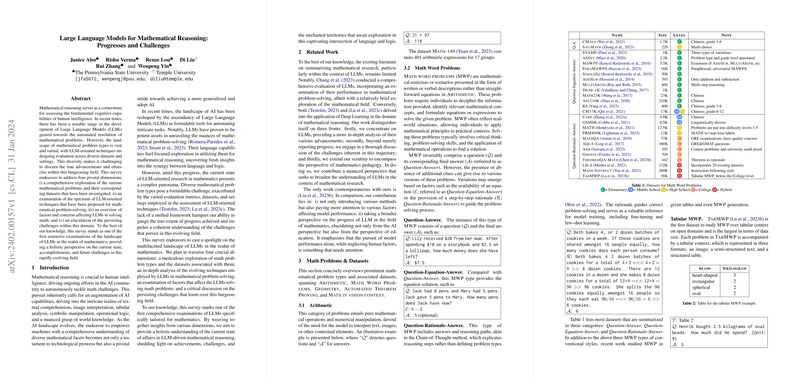Introduction
The landscape of mathematical reasoning has been substantially impacted by the rise of LLMs, which have demonstrated impressive capabilities in solving a range of mathematical problems. This paper provides a comprehensive survey of the current state of LLMs in mathematical problem-solving, laying out the diverse problem types and datasets that have been explored, as well as the techniques put in place for this purpose.
Mathematical Problem Types and Datasets
The survey categorizes mathematical problems tackled by LLMs into several domains: Arithmetic, Math Word Problems (MWP), Geometry, Automated Theorem Proving (ATP), and Math in the Vision-Language Context. Each domain presents its unique challenges and datasets. The paper details the characteristics of these problems, from the straightforward arithmetic operations to the intricate MWPs requiring textual comprehension and step-by-step reasoning. Moreover, it outlines how MWPs can vary widely, offering examples and listing key datasets, such as SVAMP and MAWPS, which aid in training and benchmarking LLMs’ mathematical abilities.
Methodologies for Enhancing LLMs’ Capabilities
The paper delineates the various methodologies deployed to augment LLMs for mathematical reasoning. These range from mere prompting of pre-trained models to more intricate techniques like fine-tuning on specialized datasets. Among the methodologies discussed is the use of external tools to verify answers, advanced prompting methods like Chain-of-Thought, which improves models’ reasoning steps, and fine-tuning strategies that entail improving intermediate step generation and learning from enhanced datasets. Consideration is also given to teacher-student knowledge distillation, emphasizing the potential for making smaller models with high proficiency in solving math problems.
Analysis and Challenges
The robustness of LLMs in mathematics is particularly scrutinized, revealing a disparity in models' abilities to maintain performance under the variation of inputs. Factors influencing LLMs in math are also examined, such as prompt efficiency, tokenization methods, and model scale, contributing to a comprehensive understanding of LLMs' arithmetic capabilities. Despite notable advancements, challenges persist in the form of LLMs' brittleness in mathematical reasoning and their limited generalization beyond data-driven approaches. Furthermore, there is a salient need for a human-centered design in LLMs to ensure usability in educational settings, addressing aspects of user comprehension and adaptive feedback.
Educational Impact and Outlook
The implications of utilizing LLMs for mathematics within educational contexts are multifaceted, with LLMs having the potential to serve as powerful tools for aiding in learning and instruction. However, the current approaches often do not address the uniqueness of individual student needs or learning styles, nor do they consider the complexity or practicality of responses in line with students’ cognitive abilities. This paper calls for a delicate balance between machine efficiency and human-centric design, to ensure that LLMs serve as effective educational supplements.
In conclusion, the survey presents an intricate tapestry of achievements and challenges in the interplay between LLMs and mathematical reasoning. LLMs have proven their worth in various mathematical domains, yet the quest for more robust, adaptive, and human-oriented solutions continues to be a dynamic area of research and development.
